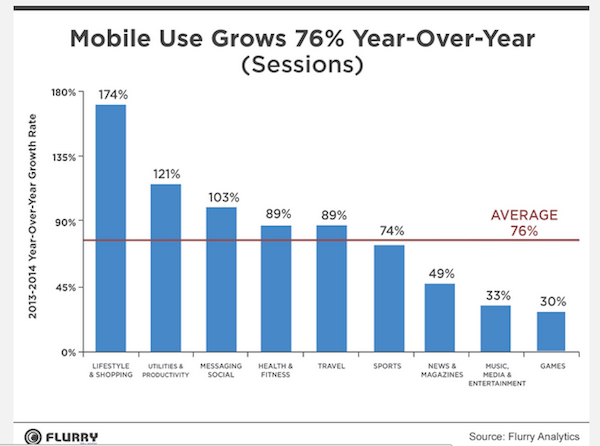Insights from CTV leaders at Dentsu, Horizon Media and more

In the shift to mobile, the tech cognoscenti agree that apps have trounced the mobile Web. Tell that to the publishers.
Despite over 14,000 apps in the Apple Newsstand alone, publishers have churned out apps in the hopes of getting a coveted piece of real estate on home screens.
And yet, news apps are becoming marginalized, according to Flurry. Across all mobile devices, app usage exploded in 2014, with user sessions up 76 percent, according to the analytics company. But the fastest growth occurred in shopping, productivity and messaging apps, while growth of news, media and games apps tapered off. The New York Times specifically has struggled to attract new readers with new ancillary apps.
Exact figures for publisher apps are hard to come by, but in the case of consumer magazines, digital subscriptions remain a tiny portion of their total circulation. Across 367 consumer magazines tracked by the Alliance for Audited Media, digital subscribers stood at 3.8 percent of their total circulation in the first half of 2014, up only from 3.3 percent a year earlier. As small as that percent is, it’s completely inflated by one publication: Game Informer, which accounts for about one-third of all digital editions.
“People keep trying, but at this point, the outlook is not good for apps,” said Steve Goldberg, managing director at Empirical Media, which consults to publishers. “It’s important that your content is accessible no matter where people want to access it. As a general rule, you get a very good user experience in an app, and you’re serving your best customers. The big challenge is, no one has really come up with a substantive way to monetize them.”
Publishers defend their apps on the basis of the consumer connection they foster, if not the ad revenue. Men’s Fitness has published two single-topic products and plans to do four this year after seeing people spend better than average time with them, publisher Patrick Connors said. Men’s Health charges about $23 for an annual subscription to its digital edition, making it a profitable, if small, business line, publisher Ronan Gardiner said.
“Certainly, from a circulation percentage it’s proving more of a revenue driver than an advertising perspective,” Gardiner said. “We do think there’s still an opportunity for it. It’s just not as great as we hoped it would be.”
It’s not just legacy publishers, either. Despite mounting evidence that news apps are not the way to go, digital natives like NowThis, BuzzFeed and Circa are all betting on apps as their core business or a complement to it.
Likewise, despite general industry trends, Tribune Broadcasting is rebuilding the apps for its 40-plus TV stations to make them more customizable.
“We see it still as an onramp to our content,” said Devin Johnson, svp and head of digital media at Tribune Broadcasting. “The app users are the crown jewel of the mobile world, because they’re seeking it out. They’re the most engaged users.”
Homepage image courtesy of Shutterstock
More in Media

LinkedIn makes it easier for creators to track performance across platforms
LinkedIn’s new API marks a strategic move to position itself more firmly in the creator economy — and make the platform more attractive to advertisers. By allowing creators to integrate performance data into third-party tools, LinkedIn is reducing friction in campaign reporting and making it easier for brand partners to assess ROI.

Ad Tech Briefing: The ‘plumbers’ posing as the unlikely saviors of the internet
After several false dawns, can Cloudflare’s ‘anti-AI scraping tool’ finally offer publishers a road to commercial redemption?

Generative AI, not ad tech, is the new antitrust battleground for Google
Global regulatory scrutiny is shifting from Google’s ad tech and search dominance to generative AI, as they aim to address the most pressing threats to publisher business models.






